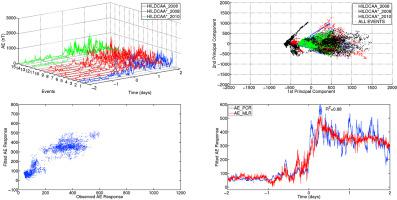当前位置:
X-MOL 学术
›
J. Atmos. Sol. Terr. Phys.
›
论文详情
Our official English website, www.x-mol.net, welcomes your
feedback! (Note: you will need to create a separate account there.)
Principal component analysis in the modeling of HILDCAAs during the Solar Minimum of Cycle 23/24
Journal of Atmospheric and Solar-Terrestrial Physics ( IF 1.8 ) Pub Date : 2021-02-01 , DOI: 10.1016/j.jastp.2020.105516 Virginia Klausner , Isabelle Cristine Pellegrini Lamin , Arian Ojeda-González , Humberto Gimenes Macedo , Claudia Maria Nicoli Cândido , Alan Prestes , Marina Vedelago Cezarini
Journal of Atmospheric and Solar-Terrestrial Physics ( IF 1.8 ) Pub Date : 2021-02-01 , DOI: 10.1016/j.jastp.2020.105516 Virginia Klausner , Isabelle Cristine Pellegrini Lamin , Arian Ojeda-González , Humberto Gimenes Macedo , Claudia Maria Nicoli Cândido , Alan Prestes , Marina Vedelago Cezarini

|
Abstract In this article, we propose a new approach to model the high-intensity, long-duration, continuous AE (Auroral Electrojet) activity (HILDCAA) by relaxing one of the criteria originally designed, based on the interplanetary features during the unusual Solar Minimum of Cycle 23/24 (SMC23/24). This relaxation does not intend to suppress or modify the original HILDCAAs’ conception, but propose a new view of the same phenomena by enlarging the sample of events, which in turn may improve space weather monitoring and prediction programs. To assess and classify the Alfvenity associated with HILDCAAs, the values of 4h-Windowed Pearson Cross-Correlation ( 4 W P C C ) between the IMF components and the solar wind speed components observed in situ at the Lagrangian point L1 (1 AU) were evaluated. The principal component analysis (PCA) was performed on the dataset and, from the first three principal components, which represent ∼ 65% of the accumulative percent variance, we applied principal component regression (PCR) in each of the following parameters: the AE index, the Interplanetary Magnetic Field (IMF) components, the plasma density, the solar wind speed, the temperature, the IMF magnitude, and the SYM-H geomagnetic index. Furthermore, we applied Multiple Linear Regression (MLR) to establish a linear model to express the AE index in terms of the PCR-based model parameters. The AE MLR-based model demonstrated to hold a prognosis potential for HILDCAAs. Despite that, this model is only suitable for the SMC23/24. In this sense, this model might be implemented a real-time analysis for short-term HILDCAA prognosis in the near future.
中文翻译:

23/24 周期太阳极小期期间 HILDCAA 建模中的主成分分析
摘要 在本文中,我们基于异常太阳活动极小期期间的行星际特征,提出了一种新方法,通过放宽最初设计的标准之一,对高强度、长时间、连续 AE(极光电喷)活动 (HILDCAA) 进行建模。周期 23/24 (SMC23/24)。这种放松并不打算压制或修改原始 HILDCAAs 的概念,而是通过扩大事件样本对相同现象提出新的观点,这反过来可能会改进空间天气监测和预测程序。为了对与 HILDCAA 相关的 Alfvenity 进行评估和分类,评估了 IMF 分量与在拉格朗日点 L1 (1 AU) 原位观察到的太阳风速分量之间的 4 小时窗口皮尔逊互相关 (4 WPCC) 值。对数据集进行了主成分分析 (PCA),从前三个主成分(代表累积百分比方差的 65%)中,我们在以下每个参数中应用了主成分回归 (PCR): AE 指数、行星际磁场 (IMF) 分量、等离子体密度、太阳风速、温度、IMF 星等和 SYM-H 地磁指数。此外,我们应用多元线性回归 (MLR) 来建立线性模型,以根据基于 PCR 的模型参数来表达 AE 指数。基于 AE MLR 的模型证明对 HILDCAA 具有预后潜力。尽管如此,该型号仅适用于 SMC23/24。从这个意义上说,该模型可能会在不久的将来实现对短期 HILDCAA 预后的实时分析。
更新日期:2021-02-01
中文翻译:

23/24 周期太阳极小期期间 HILDCAA 建模中的主成分分析
摘要 在本文中,我们基于异常太阳活动极小期期间的行星际特征,提出了一种新方法,通过放宽最初设计的标准之一,对高强度、长时间、连续 AE(极光电喷)活动 (HILDCAA) 进行建模。周期 23/24 (SMC23/24)。这种放松并不打算压制或修改原始 HILDCAAs 的概念,而是通过扩大事件样本对相同现象提出新的观点,这反过来可能会改进空间天气监测和预测程序。为了对与 HILDCAA 相关的 Alfvenity 进行评估和分类,评估了 IMF 分量与在拉格朗日点 L1 (1 AU) 原位观察到的太阳风速分量之间的 4 小时窗口皮尔逊互相关 (4 WPCC) 值。对数据集进行了主成分分析 (PCA),从前三个主成分(代表累积百分比方差的 65%)中,我们在以下每个参数中应用了主成分回归 (PCR): AE 指数、行星际磁场 (IMF) 分量、等离子体密度、太阳风速、温度、IMF 星等和 SYM-H 地磁指数。此外,我们应用多元线性回归 (MLR) 来建立线性模型,以根据基于 PCR 的模型参数来表达 AE 指数。基于 AE MLR 的模型证明对 HILDCAA 具有预后潜力。尽管如此,该型号仅适用于 SMC23/24。从这个意义上说,该模型可能会在不久的将来实现对短期 HILDCAA 预后的实时分析。











































 京公网安备 11010802027423号
京公网安备 11010802027423号